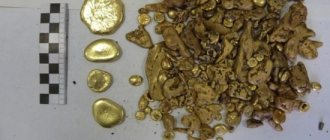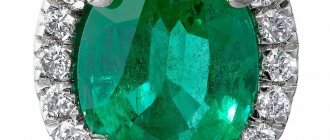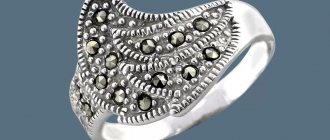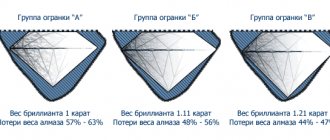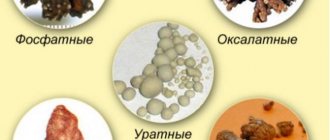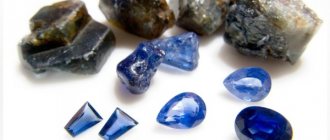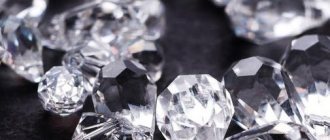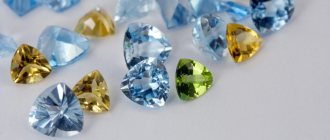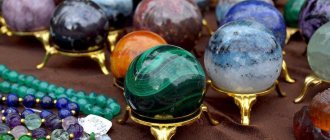Warning coloration of predatory ground beetles
| Play of colors in soap bubbles |
| Iridescent wings of the Morpho butterfly |
| Some types of mother-of-pearl have an amazing play of color (the inner surface of a mollusk shell) |
| Ammolite is a gemstone consisting of iridescent ammonite fossils |
| The wings of Tachinid fly are iridescent due to the special structure of their surface |
| Tapetum lucidum dissected from a calf's eye, appearing black and blue due to iridescence |
Irisation
(name from the Latin “
iris
” -
rainbow
, by analogy with the bright colors of the spectrum) - an optical effect that consists in the appearance of spectral-pure or “rainbow” colors, variable shades and highlights on the smooth surface of an object. Iridescence is especially pronounced in peacock feathers, on the wings of butterflies, on the surface and in the volume of some minerals, in the form of a rainbow-colored “shine.” The effect is more pronounced in bright light on even chipped stones, especially after polishing.
Physics of the phenomenon[edit | edit code]
Reflection of light from a gasoline stain - a thin layer of liquid on water
The effect is associated with the interference of white light in thin layers or in regular microstructures. 2 dn = ( m + 0.5 ) λ 2dn = (m + 0.5)\lambda Which corresponds to λ max = 2 dnm + 0.5 \lambda_{max} = \frac {2dn} {m+0.5 } 2 dn = m λ 2dn = m \lambda Which corresponds to λ min = 2 dnm \lambda_{min} = \frac {2dn} {m}
Where:
- n - refractive index
- d—
- m – 0, 1, 2, 3…
Interference pattern on the surface of a CD
Labradorite products, jewelry, talismans
All kinds of jewelry are made from Labradorite. The inserts of this stone in earrings, bracelets, rings, necklaces and cufflinks look very beautiful and unusual.
The crystal is also used to make various amulets, figurines and small decorative items. Rings or pendants with Labradorite have magical properties and can protect their owner from many negative phenomena.
Effects of iridescence in nature[edit | edit code]
Iridescence of light in minerals[edit | edit code]
Iridescence in quartz, permeated with rutile needles
Bluish-white to light blue, sometimes with golden, yellow and reddish tints, shimmering under the surface, changing at the slightest turn of the stone, often observed in potassium (adularia) and calcium-sodium (oligoclase) feldspars as a consequence of the interference of light waves on their polysynthetically twinned plates (“moonstone”, “belomorite”). In relation to another feldspar, labradorite, which has a bright silvery-blue zonal iridescence, this term was mentioned by Agricola (1546). Iridescence is also observed in some corundums and quartz, and occasionally in beryl and diopside. Stones with this effect look very interesting both on polished cuts and after processing in the form of cabochons and are widely used as an ornamental material, in jewelry and inlay.
Iridescence on a noble opal from Ethiopia Iridescence in a polished labradorite mineral (Madagascar)
Iridization in biology[edit | edit code]
The tissues of living organisms (birds, insects, fish, reptiles) during the process of their formation and growth often form anisotropic or periodic structures.
The iridescent tints of light in the elytra of beetles, on the wings of butterflies, and in the feathers of peacocks are widely known.
Formed by mollusks, mother-of-pearl and pearls have long been used as an excellent material for jewelry.
- Pearl
- Goldwespe
- Bronze beetle - Cetonia aurata
Iridescence in the atmosphere[edit | edit code]
Iridescence of light on clouds
In clouds, sometimes conditions arise for the occurrence of an iridescence effect.
“Rainbow” on glass and ceramics[edit | edit code]
Iridescence is also often called a slightly different optical effect, interference “rainbow tints” on the surface of glass, ceramics, in thin films of soap bubbles, etc.
Stone deposits
There are many deposits of Labradorite in Ukraine and Canada. These minerals are also mined in Germany, India, Tibet, Greenland and Australia. But the most valuable specimens are in Finland. There you can find the most expensive and interesting stones - spectrolites.
Black moonstone is mined in Burma, and there is a deposit of sunstone in the US state of Oregon.
Stone care
Labradorite is not a picky stone. He is not afraid of temperature changes and ultraviolet radiation. On the contrary, under the sun's rays it will replenish energy and its beneficial properties will increase.
The gem must be stored separately from other minerals. For this, a box with a soft base or a case is enough.
Wash the Labrador in warm water without adding aggressive cleaning agents; use a flannel napkin or paper towel to dry.
Despite the high strength coefficient, the stone should be protected from falls and impacts.
Optical effects of precious stones. Pleochroism.
Pleochroism is a very common optical effect, occurring to varying degrees in many minerals and gemstones. Due to this effect, there is a lot of misunderstanding about the nature of gemstones. In numerous publications, stories, descriptions on the Internet, and even in printed literature, you can often find something similar to the following phrase: “Alexandrite (garnet, tourmaline, spinel, etc.) has the effect of changing light because it has strong pleochroism...” The quote, of course, is not literal, but only “semantic”.
A categorically false statement! Pleochroism and the effect of changing light (a separate material will be devoted to this phenomenon) are two optical effects that are completely independent of each other .
We observe the effect of changing light (the alexandrite effect is implied) when the lighting changes, but at a constant angle of view on the stone . We observe pleochroism under the same lighting, but when the angle of view on the stone .
Pleochroism in sapphire. Photos by Stefan Petek. Pleochroism, to one degree or another, is characteristic of all anisotropic colored stones, that is, all stones that are birefringent (that is, having two different refractive indexes). And all minerals exhibit birefringence, with the exception of amorphous ones or those with a cubic crystalline structure. It is logical to assume (and this will be a very correct assumption) that the presence of birefringence and the presence of pleochroism depend solely on the crystal structure of the stones . The effect of color change depends on the chemical composition - on the presence of microinclusions of certain chemical elements, and, in very rare cases (chamemeon effect) on the restructuring of the electronic structure of crystal-forming atoms under the influence of light quanta (typical only for diamonds). When polarized light enters a gemstone with a cubic crystal structure, all rays travel parallel to each other. When light hits a stone with a non-cubic crystal lattice, the light rays are separated in different directions. Each of the separate rays, corresponding to different wavelengths, moves inside the crystal at different speeds, passing through the crystal faces at different angles and, accordingly, being refracted differently. All rays inside the crystal will experience various influences that lengthen or shorten their paths, will be reflected repeatedly from the crystal faces in different ways, and, accordingly, will be absorbed to varying degrees by the mass of the crystal. The logical consequence of all these difficulties in the path of light rays through the “womb” of the crystal is that rays coming out in different directions will lose different shares of their energy and will have different colors. This phenomenon is called " differential selective absorption ". Optically uniaxial stones always show 2 colors. This pleochroism is called " dichroism ". Dichroism is characteristic only of stones with a trigonal, tetragonal or hexagonal crystal system. Sometimes dichroic stones show very similar colors, essentially the same hue, but differing in tone, such as dark green and light green. Optically biaxial stones exhibit 3 colors. This pleochroism is called " trichroism ". Trichroic minerals always form in orthorhombic, monoclinic, or triclinic crystal systems. To describe the strength of pleochroism, in fact, the possibility of its visual observation (it is always determined by instruments if the stone is pleochroic) is divided into levels: 1. No (pleochroism is absent). 2. Weak. 3. Average. 4. Medium-strong. 5. Strong. For two types of gemstones, a non-standard "extremely strong" category can be applied - for Riesling beryl and for andalusite. A gemological instrument designed to detect pleochroism is a dichroscope . There is also a known non-standard method for detecting even very weak pleochroism. The light emitted by a computer monitor is highly polarized. Thanks to this, if a pleochroic stone is rotated against the background of a working monitor, even very slight “changes” in color associated specifically with pleochroism will become noticeable. In some controversial cases, pleochroism is an important “tool” for identifying stones. For example, thanks to the cubic crystal structure, garnets are never stunned by pleochroism, which helps to immediately separate them from gemstones of similar color. Wonderful illustrations of pleochroism in photographs by Eliza Skalvold (Nordskip company):
Dichroism in chrome tourmaline (dravite)
Pleochroism in andalusite (third color - green not visible in the image)
Dichroism in benitoite.
Dichroism in purple scapolite.
Dichroism in sapphire.
Dichroism in ruby.
Dichroism in pezzottaite.
Pleochroism in tanzanite (Zoisite). Blue and bluish purple are visible in the image. The bluish green is not visible in the image, but is present in this sample.
Trichroism in untreated (not heated) pink zoisite.
© www.gems4u.ru
The color of the stones and the mood of the owner
Many owners notice how their favorite stones change color for no apparent reason. This is only at first glance.
Gems selected according to the horoscope are energetically interconnected with the owner. Therefore, even non-chameleons are capable of shining with a different spectrum or dimming depending on emotions or magical influence.
As for stones with reverse or pleochroism, aquamarine and pyrope often change color depending on their mood. These chameleons either rejoice with the owner, or indicate a deterioration in health, an outburst of negative emotions, or damage.
What does the change in aquamarine color mean:
- radiates - joy, good health;
- turns green - negative experiences;
- cloudy - anger, outburst of anger, danger, problems in love;
- fades - depression, illness, melancholy.
Pyrope (ruby garnet) shimmers in the red spectrum for people with positive, strong energy. Depth of color appears in moments of sensory experience. It turns pale or dull if the owner is sick, tired or damaged.
See what faceted pyrope looks like:
Healing properties
Labradorite helps make it easier to fall asleep and protects sleep. The stone also significantly reduces increased nervousness and mental stress, helps relieve stress and gain peace of mind.
Labradorite helps to get rid of pain in the joints, spine and muscles, improves reproductive function, treats infertility and impotence. The stone improves the functioning of the kidneys and the entire genitourinary system, promotes the removal of stones.
It is believed that Labradorite helps drug addicts and alcoholics get rid of their addiction.
